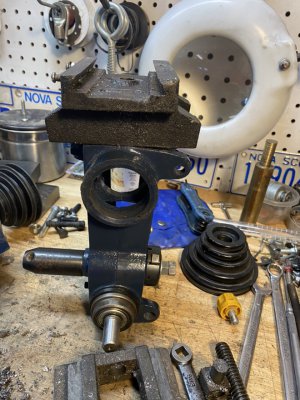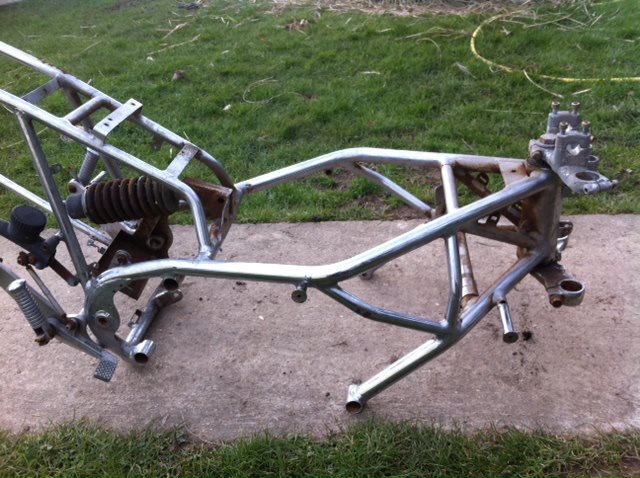- Joined
- Jan 25, 2015
- Messages
- 2,558
Been digging and searching google for options on the quill play. I ran across a mini drill/mill that mounted the head on a dovetail slide and that was the Z movement. It still had a moving quill, but it could be locked and the dovetail slide portion gave it the vertical movement.
That's not a bad idea, except I'm starting with a cheapo drill press with not enough "meat" in the casting to make a dovetail.
Then it strikes me that I bought a cheapo xy vice a long time ago. it was a piece of junk, so I tossed it aside and haven't thought about it since. I dug around in the shop where I thought it might be and pulled it out of a bin. It's still as cheap and junky as I remember with many glaring faults like the top ways that mount the vice are actually cast on there crooked to the x travel ways. literally no way to travel the y axis without making an angled cut. No es beuno.
But, the bottom casting isn't that bad, certainly workable with a little clean up/finish machining. it's got about 4-5" of travel, an acme thread screw and most of the bits that are junk on it I would be cutting away anyways. It even has a dial indicator, although I highly doubt the numbers and marks actually indicate anything beside the fact they have been moved from their original position.....
What I'm thinking is machine the back of the drill head flat, machine the top part of the bottom dovetail flat and bolt the two together.
Then all I need to do is build a solid frame for it all to mount on. I've got lots of 1/4" plate and angle laying around, so building a solid piece to mount compound slide table to and the now moveable drill head to.
4" of travel is plenty for the Z axis, at least for the small bits I do from time to time. I always have the option of lowering the quill if there's not enough travel.
At the very worst, I can at least minimize quill stick out when machining (IE: increased rigidity). It also removes nearly all the "drill press" parts that are marginal or quite flimsy.
If it works out well and I find I need more, I can always machine out a longer dovetail piece and with a longer acme screw it will give me more travel. For now, using the scrap bits I have around is at least going to give me "proof of concept" and I can refine it later on, once I know it will work acceptably.
A test fit of the dovetail slide to the back of the drill head casing reveals they"re almost the exact same size, with the dovetail casting maybe a few mm wider than the drill head casting:

Almost like it was meant to be together.....with a little work that is....
That's not a bad idea, except I'm starting with a cheapo drill press with not enough "meat" in the casting to make a dovetail.
Then it strikes me that I bought a cheapo xy vice a long time ago. it was a piece of junk, so I tossed it aside and haven't thought about it since. I dug around in the shop where I thought it might be and pulled it out of a bin. It's still as cheap and junky as I remember with many glaring faults like the top ways that mount the vice are actually cast on there crooked to the x travel ways. literally no way to travel the y axis without making an angled cut. No es beuno.
But, the bottom casting isn't that bad, certainly workable with a little clean up/finish machining. it's got about 4-5" of travel, an acme thread screw and most of the bits that are junk on it I would be cutting away anyways. It even has a dial indicator, although I highly doubt the numbers and marks actually indicate anything beside the fact they have been moved from their original position.....
What I'm thinking is machine the back of the drill head flat, machine the top part of the bottom dovetail flat and bolt the two together.
Then all I need to do is build a solid frame for it all to mount on. I've got lots of 1/4" plate and angle laying around, so building a solid piece to mount compound slide table to and the now moveable drill head to.
4" of travel is plenty for the Z axis, at least for the small bits I do from time to time. I always have the option of lowering the quill if there's not enough travel.
At the very worst, I can at least minimize quill stick out when machining (IE: increased rigidity). It also removes nearly all the "drill press" parts that are marginal or quite flimsy.
If it works out well and I find I need more, I can always machine out a longer dovetail piece and with a longer acme screw it will give me more travel. For now, using the scrap bits I have around is at least going to give me "proof of concept" and I can refine it later on, once I know it will work acceptably.
A test fit of the dovetail slide to the back of the drill head casing reveals they"re almost the exact same size, with the dovetail casting maybe a few mm wider than the drill head casting:

Almost like it was meant to be together.....with a little work that is....
Last edited:



